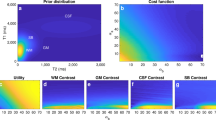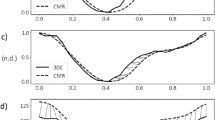Abstract
Quantitative cardiovascular magnetic resonance (CMR) imaging can be used to characterize fibrosis, oedema, ischaemia, inflammation and other disease conditions. However, the need to reduce artefacts arising from body motion through a combination of electrocardiography (ECG) control, respiration control and contrast-weighting selection makes CMR exams lengthy. Here, we show that physiological motions and other dynamic processes can be conceptualized as multiple time dimensions that can be resolved via low-rank tensor imaging, allowing for motion-resolved quantitative imaging with up to four time dimensions. This continuous-acquisition approach, which we name CMR multitasking, captures—rather than avoids—motion, relaxation and other dynamics to efficiently perform quantitative CMR without the use of ECG triggering or breath holds. We demonstrate that CMR multitasking allows for T1 mapping, T1/T2 mapping and time-resolved T1 mapping of myocardial perfusion without ECG information and/or under free-breathing conditions. CMR multitasking may provide a foundation for the development of setup-free CMR imaging for the quantitative evaluation of cardiovascular health.
This is a preview of subscription content, access via your institution
Access options
Access Nature and 54 other Nature Portfolio journals
Get Nature+, our best-value online-access subscription
$29.99 / 30 days
cancel any time
Subscribe to this journal
Receive 12 digital issues and online access to articles
$99.00 per year
only $8.25 per issue
Buy this article
- Purchase on Springer Link
- Instant access to full article PDF
Prices may be subject to local taxes which are calculated during checkout







Similar content being viewed by others
References
Moon, J. C. et al. Myocardial T 1 mapping and extracellular volume quantification: a Society for Cardiovascular Magnetic Resonance (SCMR) and CMR Working Group of the European Society of Cardiology consensus statement. J. Cardiovasc. Magn. Reson. 15, 92 (2013).
Giri, S. et al. T 2 quantification for improved detection of myocardial edema. J. Cardiovasc. Magn. Reson. 11, 56 (2009).
Atkinson, D., Burstein, D. & Edelman, R. First-pass cardiac perfusion: evaluation with ultrafast MR imaging. Radiology 174, 757–762 (1990).
Christian, T. F. et al. Absolute myocardial perfusion in canines measured by using dual-bolus first-pass MR imaging. Radiology 232, 677–684 (2004).
Lustig, M., Donoho, D. & Pauly, J. M. Sparse MRI: the application of compressed sensing for rapid MR imaging. Magn. Reson. Med. 58, 1182–1195 (2007).
Ma, D. et al. Magnetic resonance fingerprinting. Nature 495, 187–192 (2013).
Kolda, T. G. & Bader, B. W. Tensor decompositions and applications. SIAM Rev. 51, 455–500 (2009).
Hamilton, J. I. et al. MR fingerprinting for rapid quantification of myocardial T 1, T 2, and proton spin density. Magn. Reson. Med. 77, 1446–1458 (2017).
Feng, L. et al. XD-GRASP: golden-angle radial MRI with reconstruction of extra motion-state dimensions using compressed sensing. Magn. Reson. Med. 75, 775–788 (2016).
Liang, Z.-P. Spatiotemporal imaging with partially separable functions. In Proc. 4th IEEE Int. Symp. Biomed. Imaging 988–991 (IEEE, 2007).
Pedersen, H., Kozerke, S., Ringgaard, S., Nehrke, K. & Kim, W. Y. k-t PCA: temporally constrained k-t BLAST reconstruction using principal component analysis. Magn. Reson Med 62, 706–716 (2009).
Huang, C., Graff, C. G., Clarkson, E. W., Bilgin, A. & Altbach, M. I. T 2 mapping from highly undersampled data by reconstruction of principal component coefficient maps using compressed sensing. Magn. Reson. Med. 67, 1355–1366 (2012).
Lam, F. & Liang, Z.-P. A subspace approach to high-resolution spectroscopic imaging. Magn. Reson. Med. 71, 1349–1357 (2014).
Fu, M. et al. High-resolution dynamic speech imaging with joint low-rank and sparsity constraints. Magn. Reson. Med. 73, 1820–1832 (2015).
Zhao, B. et al. Accelerated MR parameter mapping with low-rank and sparsity constraints. Magn. Reson. Med. 74, 489–498 (2015).
Tamir, J. I. et al. T 2 shuffling: sharp, multicontrast, volumetric fast spin-echo imaging. Magn. Reson. Med. 77, 180–195 (2017).
Trzasko, J. D. & Manduca, A. A unified tensor regression framework for calibrationless dynamic, multi-channel MRI reconstruction. In Proc. ISMRM 21st Annual Meeting and Exhibition 603 (ISMRM, 2013).
Yu, Y., Jin, J., Liu, F. & Crozier, S. Multidimensional compressed sensing MRI using tensor decomposition-based sparsifying transform. PLoS ONE 9, e98441 (2014).
Christodoulou, A. G. & Liang, Z.-P. 3D dynamic T 1 mapping of the myocardium using a time-varying subspace. In Proc. ISMRM 23rd Annual Meeting and Exhibition 2614 (ISMRM, 2015).
Christodoulou, A. G. et al. Fast dynamic electron paramagnetic resonance (EPR) oxygen imaging using low-rank tensors. J. Magn. Reson. 270, 176–182 (2016).
He, J. et al. Accelerated high-dimensional MR imaging with sparse sampling using low-rank tensors. IEEE Trans. Med. Imaging 35, 2119–2129 (2016).
Ma, C. et al. High-resolution dynamic 31P-MRSI using a low-rank tensor model. Magn. Reson. Med. 78, 419–428 (2017).
Ferreira, V. M., Piechnik, S. K., Robson, M. D., Neubauer, S. & Karamitsos, T. D. Myocardial tissue characterization by magnetic resonance imaging: novel applications of T 1 and T 2 mapping. J. Thorac. Imaging 29, 147–154 (2014).
Messroghli, D. R. et al. Modified look-locker inversion recovery (MOLLI) for high-resolution T 1 mapping of the heart. Magn. Reson. Med. 52, 141–146 (2004).
Piechnik, S. K. et al. Shortened modified look-locker inversion recovery (ShMOLLI) for clinical myocardial T 1-mapping at 1.5 and 3 T within a 9 heartbeat breathhold. J. Cardiovasc. Magn. Reson. 12, 69 (2010).
Weingärtner, S. et al. Heart-rate independent myocardial T 1-mapping using combined saturation and inversion preparation pulses. J. Cardiovasc. Magn. Reson. 15, P46 (2013).
Chow, K. et al. Saturation recovery single-shot acquisition (SASHA) for myocardial T 1 mapping. Magn. Reson. Med. 71, 2082–2095 (2014).
Xue, H. et al. Phase-sensitive inversion recovery for myocardial T 1 mapping with motion correction and parametric fitting. Magn. Reson. Med. 69, 1408–1420 (2013).
Von Knobelsdorff-Brenkenhoff, F. et al. Myocardial T 1 and T 2 mapping at 3 T: reference values, influencing factors and implications. J. Cardiovasc. Magn. Reson. 15, 53 (2013).
Kellman, P. & Hansen, M. S. T 1-mapping in the heart: accuracy and precision. J. Cardiovasc. Magn. Reson. 16, 2 (2014).
Roujol, S. et al. Accuracy, precision, and reproducibility of four T 1 mapping sequences: a head-to-head comparison of MOLLI, ShMOLLI, SASHA, and SAPPHIRE. Radiology 272, 683–689 (2014).
Kellman, P., Chung, Y.-C., Simonetti, O. P., McVeigh, E. R. & Arai, A. E. Multicontrast delayed enhancement provides improved contrast between myocardial infarction and blood pool. J. Magn. Reson. Imaging 22, 605–613 (2005).
Blume, U. et al. Interleaved T 1 and T 2 relaxation time mapping for cardiac applications. J. Magn. Reson. Imaging 29, 480–487 (2009).
Kvernby, S. et al. Simultaneous three-dimensional myocardial T 1 and T 2 mapping in one breath hold with 3D-QALAS. J. Cardiovasc. Magn. Reson. 16, 102 (2014).
Akçakaya, M. et al. Joint myocardial T 1 and T 2 mapping using a combination of saturation recovery and T 2-preparation. Magn. Reson. Med. 76, 888–896 (2016).
DiBella, E. V., Chen, L., Schabel, M. C., Adluru, G. & McGann, C. J. Myocardial perfusion acquisition without magnetization preparation or gating. Magn. Reson. Med. 67, 609–613 (2012).
Sharif, B. et al. Non-ECG-gated myocardial perfusion MRI using continuous magnetization-driven radial sampling. Magn. Reson. Med. 72, 1620–1628 (2014).
Jerosch-Herold, M., Wilke, N., Stillman, A. E. & Wilson, R. F. Magnetic resonance quantification of the myocardial perfusion reserve with a Fermi function model for constrained deconvolution. Med. Phys. 25, 73–84 (1998).
Chen, D. et al. Quantification of myocardial blood flow using non-ECG-triggered MR imaging. Magn. Reson. Med. 74, 765–771 (2015).
Muehling, O. M. et al. Regional heterogeneity of myocardial perfusion in healthy human myocardium: assessment with magnetic resonance perfusion imaging. J. Cardiovasc. Magn. Reson. 6, 499–507 (2004).
Lee, J.-H., Li, X., Sammi, M. K. & Springer, C. S. Using flow relaxography to elucidate flow relaxivity. J. Magn. Reson. 136, 102–113 (1999).
Likhite, D. et al. Interstudy repeatability of self-gated quantitative myocardial perfusion MRI. J. Magn. Reson. Imaging 43, 1369–1378 (2016).
Tucker, L. R. Some mathematical notes on three-mode factor analysis. Psychometrika 31, 279–311 (1966).
Liu, J., Musialski, P., Wonka, P. & Ye, J. Tensor completion for estimating missing values in visual data. IEEE Trans. Pattern Anal. Mach. Intell. 35, 208–220 (2013).
Larson, A. C. et al. Self-gated cardiac cine MRI. Magn. Reson. Med. 51, 93–102 (2004).
Candès, E. J. & Tao, T. The power of convex relaxation: near-optimal matrix completion. IEEE Trans. Info. Theory 56, 2053–2080 (2010).
De Lathauwer, L., De Moor, B. & Vandewalle, J. A multilinear singular value decomposition. SIAM J. Matrix Anal. Appl. 21, 1253–1278 (2000).
Nezafat, R. et al. B 1-insensitive T 2 preparation for improved coronary magnetic resonance angiography at 3 T. Magn. Reson. Med. 55, 858–864 (2006).
Staewen, R. S. et al. 3-D FLASH imaging using a single surface coil and a new adiabatic pulse, BIR-4. Invest. Radiol. 25, 559–567 (1990).
Brown, R. et al. Effect of blood flow on double inversion recovery vessel wall MRI of the peripheral arteries: quantitation with T 2 mapping and comparison with flow-insensitive T 2-prepared inversion recovery imaging. Magn. Reson. Med. 63, 736–744 (2010).
Pintaske, J. et al. Relaxivity of gadopentetate dimeglumine (Magnevist), gadobutrol (Gadovist), and gadobenate dimeglumine (MultiHance) in human blood plasma at 0.2, 1.5, and 3 Tesla. Invest. Radiol. 41, 213–221 (2006).
Shen, Y. et al. T 1 relaxivities of gadolinium-based magnetic resonance contrast agents in human whole blood at 1.5, 3, and 7 T. Invest. Radiol. 50, 330–338 (2015).
Acknowledgements
This work was supported by NIH 1R01HL124649 and NIH T32HL116273.
Author information
Authors and Affiliations
Contributions
A.G.C. conceived the imaging framework, wrote the reconstruction and parameter-fitting software, programmed the pulse-sequence sampling scheme, performed the analysis and prepared most of the manuscript. A.G.C., J.L.S. and D.L. designed the native T1 mapping and first-pass myocardial perfusion T1 mapping method and experiments, which were conducted by J.L.S. and A.G.C. C.N. designed the T2IR preparation pulse and programmed it into the pulse sequence. A.G.C., Y.X., N.W., C.N., J.L.S. and D.L. designed the T1/T2 mapping method and healthy volunteer experiments, which were conducted by A.G.C., J.L.S. and C.N. A.G.C., Q.Y. and D.L. designed the patient T1/T2 mapping experiments, which were conducted by Q.Y. J.L.S performed the myocardial T1 reconstructions. A.G.C. performed the T1/T2 and first-pass myocardial perfusion T1 mapping reconstructions. All authors reviewed and edited the manuscript. D.L. supervised the work.
Corresponding author
Ethics declarations
Competing interests
D.L., A.G.C., J.L.S., Y.X. and C.N. have a provisional patent application entitled ‘Low-rank tensor imaging for multidimensional cardiovascular MRI’ (USSN 15/495,588).
Additional information
Publisher’s note: Springer Nature remains neutral with regard to jurisdictional claims in published maps and institutional affiliations.
Supplementary information
Supplementary Information
Supplementary figures, tables, notes, methods and references.
Supplementary Video 1
Multitasking image with three time dimensions: inversion time, cardiac phase and respiratory phase.
Rights and permissions
About this article
Cite this article
Christodoulou, A.G., Shaw, J.L., Nguyen, C. et al. Magnetic resonance multitasking for motion-resolved quantitative cardiovascular imaging. Nat Biomed Eng 2, 215–226 (2018). https://doi.org/10.1038/s41551-018-0217-y
Received:
Accepted:
Published:
Issue Date:
DOI: https://doi.org/10.1038/s41551-018-0217-y
This article is cited by
-
Magnetic resonance myocardial T1ρ mapping
Journal of Cardiovascular Magnetic Resonance (2023)
-
Free-breathing and instantaneous abdominal T2 mapping via single-shot multiple overlapping-echo acquisition and deep learning reconstruction
European Radiology (2023)
-
Dynamic cardiac MRI with high spatiotemporal resolution using accelerated spiral-out and spiral-in/out bSSFP pulse sequences at 1.5 T
Magnetic Resonance Materials in Physics, Biology and Medicine (2023)
-
Accelerated cardiac T1 mapping in four heartbeats with inline MyoMapNet: a deep learning-based T1 estimation approach
Journal of Cardiovascular Magnetic Resonance (2022)
-
Cardiac MR fingerprinting with a short acquisition window in consecutive patients referred for clinical CMR and healthy volunteers
Scientific Reports (2022)



